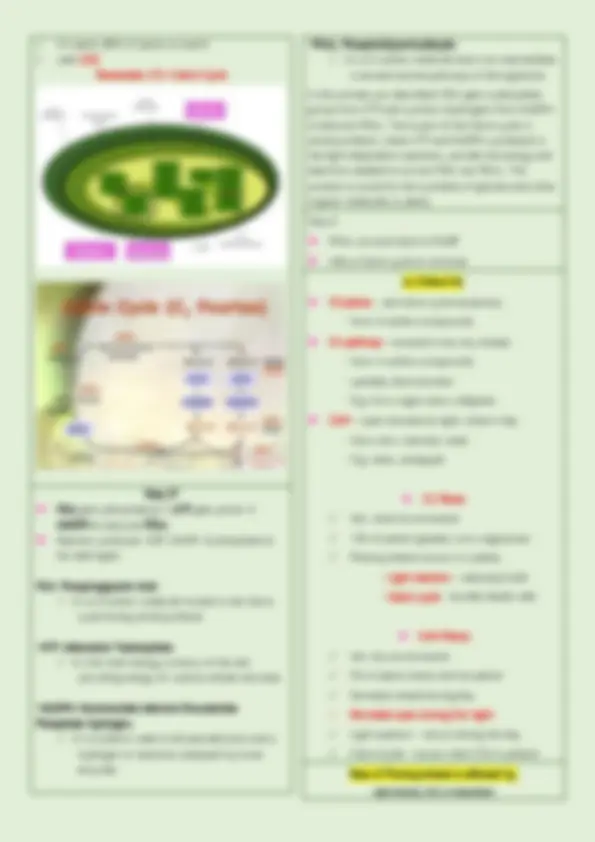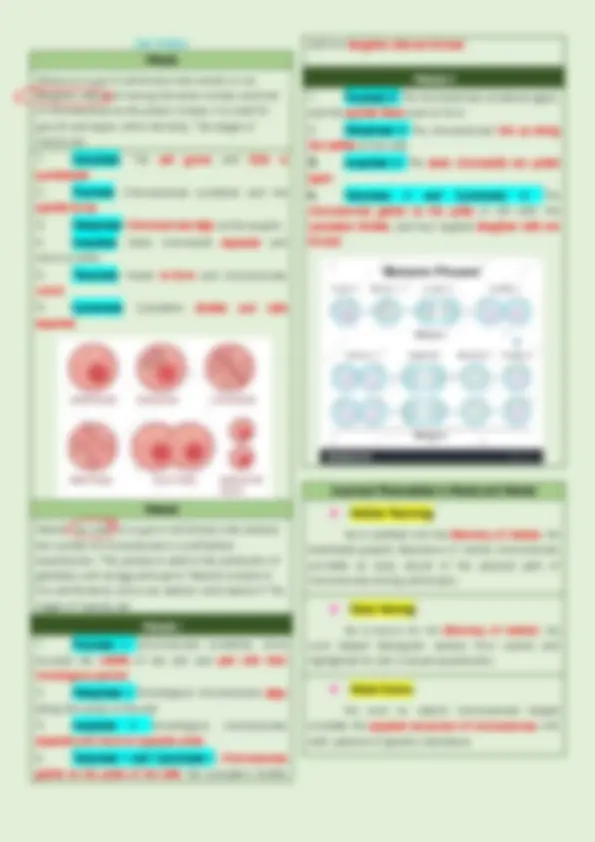





Study with the several resources on Docsity

Earn points by helping other students or get them with a premium plan


Prepare for your exams
Study with the several resources on Docsity

Earn points to download
Earn points by helping other students or get them with a premium plan
Community
Ask the community for help and clear up your study doubts
Discover the best universities in your country according to Docsity users
Free resources
Download our free guides on studying techniques, anxiety management strategies, and thesis advice from Docsity tutors
Photosynthesis, Cell Division, 1st year college in the program of Psychology in the year 2024-2025.
Typology: Lecture notes
1 / 6

This page cannot be seen from the preview
Don't miss anything!




♥ Pigment - a compound that absorbs light. ♥ Chlorophyll - a pigment that absorbs red and blue light (photons) so green is reflected or transmitted.
Parts: ♥ Chloroplasts - double membrane organelle that absorbs light energy. ♥ Thylakoids - flattened sacs contain pigment - chlorophyll ♥ Grana (pl: granum) - layered thylakoids (like pancakes) ♥ Stroma - solution around thylakoids ♥ Stromata - pore on underside of leaf where O (oxygen) is released and CO2 (carbon dioxide) enters What do cells use for energy? ♥ Sunlight is the ultimate energy for all life on earth ♥ Plant story energy in the chemical bonds of sugars ♥ Chemical energy is released as ATP during cellular respiration. ♥ ATP stands for adenosine triphosphate √ Composed of the nitrogen base ADENINE, the pentos (5C) sugar RIBOSE, and three PHOSPHATE groups √ The LAST phosphate group is bonded with a HIGH ENERGY chemical bond √ This bond is BROKEN to release ENERGY for CELLS to use ♥ Removing a Phosphate from ATP √ Breaking the LAST OHOSPHATE bond from ATP, will ---
√ High intensity or high CO2 = high rate
Mitosis Mitosis is a type of cell division that results in two daughter cells each having the same number and kind of chromosomes as the parent nucleus. It is used for growth and repair within the body. The stages of mitosis are:
synthesized.
spindle forms.
move to poles.
uncoil.
separate. Meiosis Meiosis "sex cells" is a type of cell division that reduces the number of chromosomes in a cell before reproduction. This process is used in the production of gametes, such as egg and sperm. Meiosis consists of two cell divisions, known as meiosis I and meiosis II. The stages of meiosis are: Meiosis I
towards the middle of the cell, and pair with their homologous partner.
along the center of the cell.
separate and move to opposite poles.
gather at the poles of the cells. the cytoplasm divides and two daughter cells are formed. Meiosis II
and the spindle fibers start to form.
the middle of the cells.
apart.
chromosomes gather at the poles of the cells, the cytoplasm divides, and four haploid daughter cells are formed. Important Personalities in Mitosis and Meiosis ♥ Walther Flemming: He is credited with the discovery of mitosis. His handmade graphic depictions of mitotic chromosomes provided an early record of the physical path of chromosomes during cell division. ♥ Oscar Hertwig: He is known for his discovery of meiosis. His work helped distinguish meiosis from mitosis and highlighted its role in sexual reproduction ♥ Walter Sutton: His work on meiotic chromosomes helped correlate the physical movement of chromosomes with cells’ patterns of genetic inheritance.